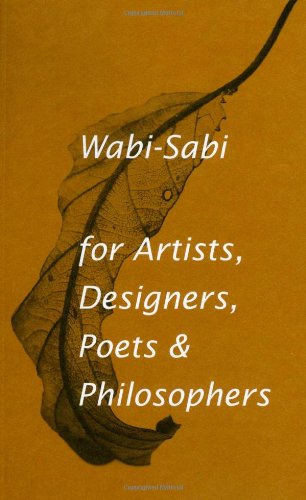Books |
Wabi-Sabi
Leonard Koren
By
Published: Mar 02, 2021
Category:
Art and Photography
Raymond Chandler’s manuscripts were perfect. That’s because he typed on half sheets of paper. As soon as he made a typo — this was so long along Wite-Out hadn’t been invented — he ripped the half page out of the typewriter and started again.
On March 13, we’ll mark the one year anniversary of a date that seems a lifetime ago: the declaration of a national emergency and a travel ban of non-US citizens traveling from Europe. Of the many lessons we’ve learned, it’s fair to say we’ve learned a great deal about imperfection. If you know anything about Tom Ford,the designer and film director who is never less than perfect, consider this, from the Times, summing up this year:
TF: I have everything in the world, but I think everyone has felt a certain depression. It’s been a very turbulent year. And I have a child at home who hasn’t been to school in a year. So, unfortunately, I have not felt as creative as I thought I was going to feel.
NYT: What do you do in that situation?
TF I go to bed. Maybe I drink some coffee and lie in the bathtub and probably watch way too much CNN and MSNBC and just make myself even more agitated. I try to get some sleep, which I never get. I just lie in bed and stare at the ceiling.
So this is a good time to consider Wabi-sabi, which dates from the 12th century.
And it’s not surprising that Leonard Koren has been Wabi-sabi’s representative in the West. Educated as an architect, he founded Wet: The Magazine of Gourmet Bathing, which was wildly ahead-of-its-time. As was his next incarnation:
In 1992, while living in Japan, I embarked on a project to locate and define the kind of beauty that I felt most deeply attracted to. By “beauty” I meant that complex of exciting, pleasurable sensations ostensibly emanating from things — objects, environments, and even ideas — that make us feel more alive and connected to the world; that urgent feeling we equate with “the good,” “the right” and “the true.”
Instinctively I was drawn to the beauty of things coarse and unrefined; things rich in raw texture and rough tactility. Often these things are reactive to the effects of weathering and human treatment. I loved the tentative, delicate traces left by the sun, the wind, the heat, and the cold. I was fascinated by the language of rust, tarnish, warping, cracking, shrinkage, scarring, peeling, and other forms of attrition visibly recorded.
I gravitated toward things that reduced the emotional distance between them and me; things that beckoned me to get closer, to touch, to relate with.
I encapsulated my new domain in the phrase “a beauty of things imperfect, impermanent, and incomplete.”
In 1994, Koren published “Wabi-Sabi for Artists, Designers, Poets & Philosophers” and, in just 88 pages, dealt a massive blow to our ideas about progress, quality and perfection. Koren is more than a writer; he does most of the photography for his books and designs them. In this case, the book is, literally, an example of the ideas it contains. [To buy the paperback of “Wabi-Sabi for Artists, Designers, Poets & Philosophers” from Amazon, click here.]
You can find the origins of Wabi-sabi in the Japanese tea ceremony. Over the centuries, it became a highly formalized ritual — and an expensive one, with tea served in exquisite cups in rooms decorated with rare art. Then a Zen monk began to mix local utensils with the fine china. Rough against smooth? It was a new concept of beauty.
The beauty of imperfection. Of the ordinary. Of age. Of the small.
In the book, Koren tells the story of a student who wanted to work with a great tea master. His “entrance exam” called for him to clean the tea master’s leaf-strewn garden. “First he raked until the grounds were spotless,” Koren writes. “Then, in a gesture pregnant with Wabi-sabi overtones, he shook the tree trunk, causing a few leaves to fall.” That’s Wabi-sabi. Clean but not too clean.
The implications cascade. Like: Beauty isn’t the result of creation alone, it’s also determined by time. Like: Beauty depends as much on your reaction as it does on the object. Like: It’s easy to overlook Beauty because it’s so often unobtrusive.
What is Beauty?
Wabi-sabi represents the exact opposite of the Western ideal of great beauty as something monumental, spectacular, and enduring. Wabi-sabi is not found in nature at moments of bloom and lushness, but at moments of inception or subsiding. Wabi-sabi is not about gorgeous flowers, majestic trees, or bold landscapes. Wabi-sabi is about the minor and the hidden, the tentative and the ephemeral: things so subtle and evanescent they are invisible to the vulgar eyes.
Like homeopathic medicine, the essence of wabi-sabi is apportioned in small doses. As the dose decreases, the effect becomes more potent, more profound. The closer things get to nonexistence, the more exquisite and evocative they become. Consequently to experience wabi-sabi means you have to slow way down, be patient, and look very closely.
Slow down. Be patient (if you can). Let time.. flow. See why I’m fond of the concept? [For a New York Times profile of Leonard Koren, click here.]
You can’t find Wabi-sabi in a super-polished, nothing-left-to-chance Apple store, but I’ll bet there’s in your home today. And who can say what looking closer at things can lead to?
OTHER BOOKS BY LEONARD KOREN
Making WET: The Magazine of Gourmet Bathing
The Flower Shop: Charm, Grace, Beauty & Tenderness in a Commercial Context
Leonard Koren’s web site.


